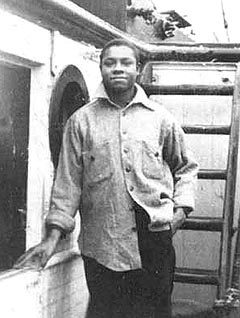GIBBS-GEORGE
GEORGE WASHINGTON GIBBS JR

SDC

FIRST AFRICAN-AMERICAN TO SET FOOT IN ANTARCTICA
George Washington Gibbs Jr. was born on November 7, 1916, in Jacksonville, Florida, but spent his youth in Brooklyn, New York. The 1920s and 1930s were not exactly a time of racial tolerance in the United States and after a brief period working in the Civilian Conservation Corps, he enlisted in the Navy in 1935 in Macon, Georgia, seeing it as a way forward to a better life. He was encouraged to volunteer for assignment with the U.S. Antarctic Service Expedition III (1939-1941) led by the famous polar explorer RADM Richard E. Byrd and was among the forty Navy men chosen from 2,000 applicants. He served as a Mess Attendant 1st Class aboard the lead expedition ship, USS BEAR, and also worked as a cook and performed other tasks with the expedition. By the end of the expedition he was an Officer’s Cook 3rd Class. Despite the long working days, Gibbs kept a journal during the expedition in which he praised the ship’s captain, the spirit of cooperation among most of the Navy and civilian members of the expedition and he wrote:
“I was the first man aboard the ship to set foot in Little America and help tie her lines deep into the snow. I met Admiral Byrd, he shook my hand and welcomed me to Little America and for being the first Negro to set foot in Little America.”
Gibbs helped to establish the West Base, Little America III, near the Bay of Whales, and the East Base on Stonington Island, Antarctic Peninsula. He twice made round trips between the United States and Antarctica. One of his assignments was to assist in catching Adelie penguins for the Smithsonian Institution which was dangerous work because the men had to work without a radio from a rowboat in fog and only the sound of the ship’s horn to give them bearings to find their way back to the ship. The Commanding Officer of BEAR twice commended Gibbs at meritorious mast, “For his zeal, initiative and untiring industry, entailing much personal sacrifice,“ and at the end of the expedition, “For his outstanding zeal and energy, and for the unusual spirit of loyalty and cooperation which he has invariably displayed under trying conditions encountered during the assignment of this vessel to duty with the U.S. Antarctic Service.”
During World War II, Gibbs served in combat in the Pacific where he was a gunner aboard the USS ATLANTA which was sunk on November 13, 1942, during engagement with Japanese forces in the Battle of Guadalcanal. Approximately a third of the ATLANTA’s crew were killed but after a night in shark infested waters, Gibbs was successfully rescued. Following the war he remained in the Navy until 1959 when he retired as a Chief Steward. Upon retirement, SDC Gibbs attended the University of Minnesota, graduating with a Bachelor of Science degree in Education. From 1963 to 1982 he worked in the personnel department of IBM at Rochester, Minnesota, following which he founded an employment agency which he operated until 1999. SDC Gibbs also became a civil rights leader and in 1966 helped organize the Rochester, Minnesota, Chapter of the National Association for the Advancement of Colored People (NAACP). In another of his activities he helped integrate the Elks Club at Rochester, was president of the Rochester Kiwanis, an active member of the Rochester chapter of the University of Minnesota Alumni Association, chairman of a Boy Scout Troop, the United Negro College Fund of Southeast Minnesota and an active member of a Methodist Church. Concerning SDC Gibbs it has been written that the Antarctic trip was the background for him to understand that contribution was important no matter who you are and from what angle you’re doing it, and that his life was about working for the community, getting people involved and looking at how everyone can make a difference.
Following his death on his birthday on November 7, 2000, he was honored in 2009 when the George W. Gibbs Jr. Elementary School in Rochester, Minnesota, was named for him. That same year the U.S. Advisory Committee on Antarctic Names honored him, stating he was the first black explorer to set foot on the Antarctic Continent and naming Gibbs Point, a rock point on the Antarctic Peninsula, the most northern area of Antarctica, for him.
Submitted by CDR Roy A. Mosteller, USNR (Ret)

